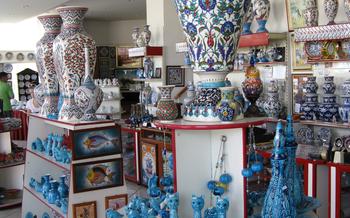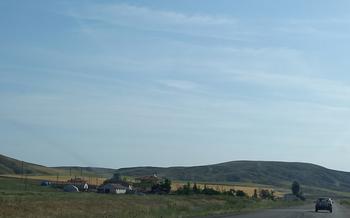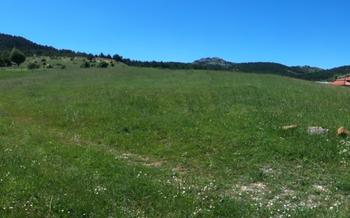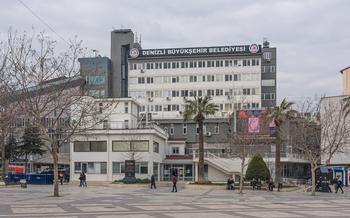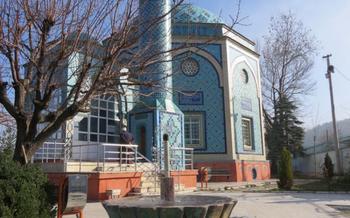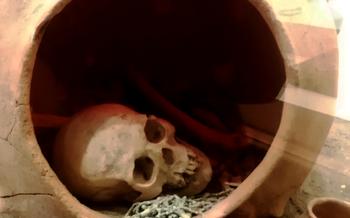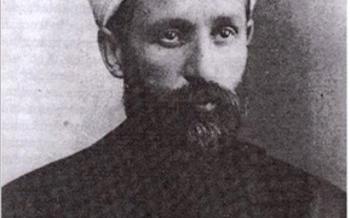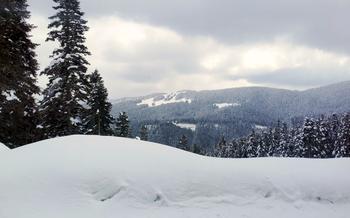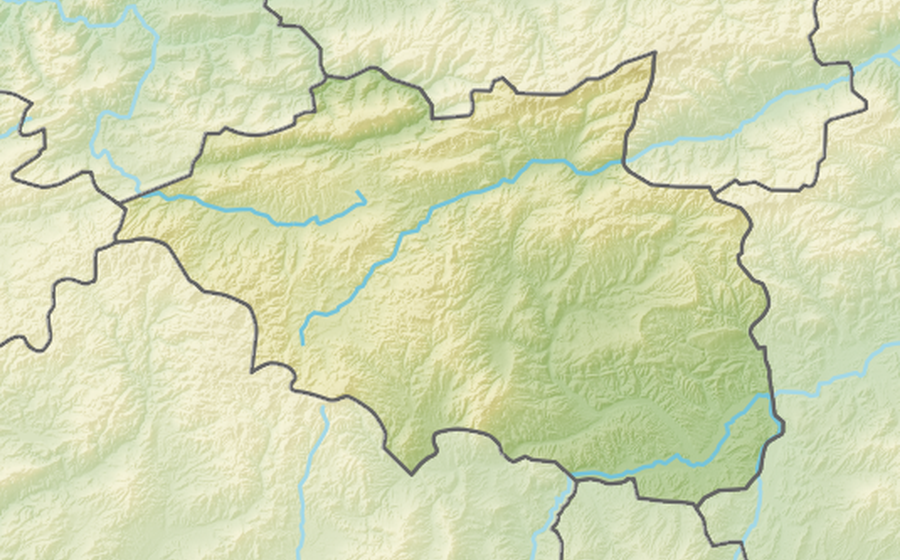
The Çankırı Yazılıkaya Frig Valley
- A Journey to Çankırı's Ancient Past:
- Stepping into the Valley of Wonders
- Unveiling the Phrygian Legacy
- Exploring the Yazılıkaya Monument
- Inside the Phrygian Tombs
- The Valley's Natural Wonders
- A Glimpse into Phrygian Daily Life
- Çankırı Museum: A Treasure Trove of Phrygian Artifacts
- Local Delights: Savoring Çankırı's Cuisine
- Exploring Beyond the Valley
- Practical Information for Visitors
- Unveiling the Secrets of the Phrygian Language
- Preserving the Legacy: Conservation Efforts
- The Phrygians in History
- Insider Tip: Hidden Gems Off the Beaten Path
A Journey to Çankırı's Ancient Past:
Unveiling the Secrets of the Yazılıkaya Frig Valley
Journey to the heart of ancient Anatolia, where history intertwines with nature in the enchanting Yazılıkaya Frig Valley. This captivating valley, located in the Çankırı province of Turkey, holds a treasure trove of Phrygian heritage, inviting travelers to delve into the mysteries of a civilization that once flourished in this land.
The Phrygians, an enigmatic people of Indo-European origin, left an indelible mark on the history of Anatolia. Their kingdom, established in the 12th century BC, spanned a vast territory and played a significant role in the region's cultural and political landscape. The Yazılıkaya Valley, with its rich collection of rock-cut monuments, sanctuaries, and inscriptions, offers a glimpse into the lives, beliefs, and artistic expressions of this ancient civilization.
Strategically positioned along ancient trade routes, the valley served as a crossroads for cultural exchange and commerce. Its proximity to major cities like Ankara and Istanbul makes it easily accessible for travelers seeking an off-the-beaten-path adventure.
As you explore the Yazılıkaya Valley, you'll discover a cultural and historical treasure trove that will transport you back in time. Prepare to be captivated by the Phrygian legacy, as you decipher the stories etched into the rocks and uncover the secrets of a civilization that once thrived in this enchanting valley.
Stepping into the Valley of Wonders
The Yazılıkaya Valley is not only a treasure trove of ancient history but also a breathtaking natural wonder. As you enter the valley, you are greeted by a stunning landscape that seems to have been painted by the gods themselves. The towering rock formations, each with its unique shape and texture, create a sense of awe and wonder. The valley's unique geological features, formed by millions of years of erosion, add to its charm, making it a true feast for the eyes.
The valley exudes an aura of serenity and tranquility, providing a welcome respite from the hustle and bustle of city life. The sound of birdsong fills the air, and the gentle breeze rustles through the leaves of the trees, creating a symphony of nature. The valley's peaceful atmosphere invites you to slow down, relax, and immerse yourself in the beauty that surrounds you.
For those with a passion for photography, the Yazılıkaya Valley is a true paradise. The stunning vistas, picturesque corners, and unique rock formations offer endless opportunities to capture breathtaking images. Whether you are a professional photographer or simply enjoy taking pictures as a hobby, you will find yourself constantly reaching for your camera to capture the valley's magic.
The valley is also home to a network of hiking trails that wind through its rugged terrain, providing opportunities for exploration and adventure. These trails offer varying levels of difficulty, catering to hikers of all fitness levels. As you hike through the valley, you will discover hidden caves, cascading waterfalls, and breathtaking viewpoints that reveal the valley's beauty from different perspectives.
Unveiling the Phrygian Legacy
The Yazılıkaya Valley is home to an impressive collection of rock-cut monuments, sanctuaries, and reliefs that provide a glimpse into the rich cultural heritage of the Phrygians. These ancient structures, carved directly into the valley's rock formations, stand as testaments to the Phrygians' exceptional artistry and craftsmanship.
Among the most notable monuments is the Yazılıkaya Monument, which features intricate carvings depicting gods, goddesses, and scenes from Phrygian mythology. The reliefs showcase a unique blend of Anatolian and Near Eastern influences, reflecting the Phrygians' position as a crossroads of civilizations.
Another highlight of the valley are the Phrygian tombs, which showcase the Phrygians' distinctive burial practices and architectural style. These elaborate tombs, often adorned with intricate facades and vaulted chambers, offer insights into the Phrygians' beliefs about the afterlife.
Additionally, the valley contains numerous Phrygian inscriptions, providing valuable clues about the Phrygian language and writing system. These inscriptions have played a crucial role in deciphering the Phrygian language, shedding light on their history, beliefs, and interactions with other ancient civilizations.
Exploring the Yazılıkaya Monument
The Yazılıkaya Monument stands as the crowning jewel of the Yazılıkaya Frig Valley, a testament to the artistic prowess of the Phrygians. This extraordinary monument features a stunning array of reliefs that adorn its facade, depicting gods, goddesses, and scenes from Phrygian mythology with intricate detail. The monument served as a religious and ceremonial center, hosting festivals and rituals that held deep significance for the Phrygian community. Ongoing archaeological excavations at the site continue to uncover new discoveries and insights, shedding light on the rich cultural and religious practices of this ancient civilization.
Inside the Phrygian Tombs
The Phrygian tombs, carved into the rocky slopes of the Yazılıkaya Valley, offer a glimpse into the funerary customs and beliefs of this ancient civilization. Their distinctive architecture, featuring vaulted chambers and elaborate facades adorned with intricate carvings, showcases the Phrygians' architectural prowess. Inside the tombs, archaeologists have discovered a wealth of artifacts, including jewelry, pottery, and metalwork, providing valuable insights into Phrygian craftsmanship and daily life. These tombs serve as a testament to the Phrygians' reverence for their ancestors and their belief in an afterlife. Ongoing efforts are underway to protect and preserve these ancient tombs, ensuring their legacy remains intact for future generations.
The Valley's Natural Wonders
The Yazılıkaya Valley is not only a treasure trove of ancient history but also a haven for nature enthusiasts. The valley's diverse ecosystem supports a wide variety of flora and fauna, creating a vibrant tapestry of life. Visitors can spot colorful wildflowers, towering trees, and an array of bird species that fill the air with their melodious songs.
As the seasons change, the valley transforms into a kaleidoscope of colors. In spring, the landscape bursts into life with a profusion of wildflowers, painting the valley in hues of pink, yellow, and purple. Summer brings a verdant greenness, as the trees and shrubs reach their full glory, creating a cool and shady retreat from the summer heat.
Autumn paints the valley in warm and inviting tones. The leaves of the trees turn golden brown, orange, and red, creating a breathtaking spectacle. The valley's panoramic views are simply stunning. From the vantage points, visitors can feast their eyes on the rolling hills, lush forests, and distant mountains that frame this natural paradise.
Whether you're a nature lover, a photographer, or simply someone seeking a tranquil escape from the hustle and bustle of city life, the Yazılıkaya Valley offers a serene and rejuvenating experience. Take a leisurely hike, soak in the beauty of the surroundings, and let the tranquility of nature wash away your worries.
A Glimpse into Phrygian Daily Life
Peering into the remnants of Phrygian houses and settlements within the Yazılıkaya Valley offers a fascinating glimpse into their daily life and urban planning. These structures reveal the Phrygians' architectural prowess, showcasing vaulted chambers, elaborate facades, and intricate designs. Exploring these dwellings provides insights into the domestic sphere of this ancient civilization, shedding light on their family life, social customs, and economic activities.
The Phrygians sustained their community through diverse economic pursuits. Agriculture formed the backbone of their economy, with farmers cultivating crops such as wheat, barley, and grapes in the fertile lands surrounding the valley. Additionally, the Phrygians engaged in trade, exchanging goods with neighboring regions. Their skilled artisans crafted exquisite pottery, textiles, and metalwork, which were highly sought after. These economic activities contributed to the prosperity and stability of the Phrygian society.
The social structure of the Phrygians was hierarchical, with a ruling class comprising kings, priests, and nobles governing the society. Beneath them were artisans, farmers, and laborers who formed the majority of the population. Despite this hierarchy, there is evidence of social mobility, as individuals could rise through the ranks based on merit and achievements.
The Phrygians' interactions with neighboring civilizations, such as the Hittites, Lydians, and Persians, shaped their unique cultural identity. They adopted and adapted various cultural elements from these interactions, resulting in a rich and diverse cultural heritage. The Phrygians left an indelible mark on the history of Anatolia, and their legacy continues to inspire and intrigue scholars and visitors alike.
Çankırı Museum: A Treasure Trove of Phrygian Artifacts
The Çankırı Museum stands as a testament to the rich cultural heritage of the Phrygians. Within its walls, a treasure trove of artifacts unearthed from the Yazılıkaya Valley awaits exploration. Exquisite Phrygian sculptures, each a masterpiece of ancient artistry, adorn the museum's galleries. Gaze upon statues that seem to breathe life, reliefs that narrate tales of gods and heroes, and decorative elements that showcase the Phrygians' unparalleled craftsmanship.
The museum's collection of pottery and ceramics offers a glimpse into the daily lives of the Phrygians. From humble household items to intricately painted vessels, these artifacts reveal the Phrygians' mastery of ceramics and their unique artistic style. Interactive displays and multimedia presentations bring the museum's exhibits to life, enhancing the visitor experience and making the Phrygian culture accessible and engaging for all.
Local Delights: Savoring Çankırı's Cuisine
Çankırı's culinary traditions are a delectable blend of flavors and influences, reflecting the region's rich history and diverse agricultural bounty. Visitors to the Yazılıkaya Valley can embark on a culinary adventure, savoring the unique tastes and aromas of local dishes.
Must-try delicacies include keşkek, a hearty dish made from wheat, meat, and yogurt, cooked slowly in a wood-fired oven. Mantı, Turkish ravioli filled with minced meat and topped with a yogurt-based sauce, is another local favorite. For a sweet treat, höşmerim, a phyllo pastry filled with shredded chicken or minced meat and sweetened with honey, is a must-try.
Exploring the vibrant local markets is a fantastic way to immerse oneself in Çankırı's culinary culture. Here, visitors can find fresh produce, handmade crafts, and authentic Turkish delights. Local restaurants and cafes offer a taste of the region's culinary heritage, serving traditional dishes prepared with passion and local ingredients.
Exploring Beyond the Valley
Venturing beyond the Yazılıkaya Valley unveils a treasure trove of additional attractions that enrich the exploration of Çankırı. History buffs will delight in discovering the Çankırı Castle, a formidable fortress that has stood guard over the region for centuries. Its imposing walls and towers offer a glimpse into the city's rich past and provide panoramic views of the surrounding landscape.
The Ulu Mosque, with its elegant architecture and intricate tilework, showcases the region's Islamic heritage. Built in the 14th century, it remains a significant center of worship and a testament to the city's religious devotion.
For those seeking a deeper dive into Çankırı's Ottoman legacy, the Ottoman-era buildings scattered throughout the city offer a tangible connection to a bygone era. These structures, with their distinctive architectural features, provide a glimpse into the city's transformation under Ottoman rule.
Nature enthusiasts will find solace in the stunning natural landscapes that surround the Yazılıkaya Valley. Waterfalls cascading down rocky cliffs, hidden caves beckoning for exploration, and scenic viewpoints revealing breathtaking panoramas await those who venture off the beaten path.
Cultural experiences abound in Çankırı, offering visitors a chance to immerse themselves in the region's vibrant traditions. Traditional music and dance performances showcase the unique artistic expressions of the local people, while craft workshops provide hands-on opportunities to learn ancient techniques and create your own handmade souvenirs. Local festivals, steeped in centuries of tradition, offer a glimpse into the heart and soul of Çankırı's culture.
Practical Information for Visitors
Planning a visit to the Yazılıkaya Valley requires careful consideration of several practical aspects. Getting there is relatively straightforward, with public transportation options available from Çankırı city center or nearby towns. Driving is also an option, and detailed directions can be found online or through local tourism offices.
Accommodation in the vicinity of the valley ranges from budget-friendly guesthouses to comfortable hotels, catering to different travel styles and budgets. It's advisable to book accommodations in advance, especially during peak tourist season, to secure a comfortable stay.
To delve deeper into the valley's history and significance, guided tours led by local experts are highly recommended. These tours provide valuable historical context and insights, enhancing the overall visitor experience. Guided tours can be arranged through local tourism agencies or directly at the valley's visitor center.
Before embarking on your journey, it's essential to pack appropriate clothing and footwear. The terrain in the valley can be uneven and rocky, so comfortable shoes are a must. Consider the weather conditions and pack accordingly, as temperatures can vary depending on the time of year.
Finally, remember to bring essential travel documents, such as your passport or national ID card, as well as any necessary permits or fees. These requirements can change, so checking with local authorities or tourism offices beforehand is advisable.
Unveiling the Secrets of the Phrygian Language
The Phrygian language remains an enigma, captivating the interest of linguists and historians alike. Deciphering this ancient tongue has proven challenging due to the scarcity of written records and the lack of a known cognate language. Despite these obstacles, scholars have made significant progress in unraveling the mysteries of Phrygian through meticulous analysis and comparative studies.
The discovery of bilingual inscriptions, featuring both Phrygian and Greek or Aramaic texts, has been instrumental in shedding light on the Phrygian language. These inscriptions have provided valuable clues, allowing researchers to identify and interpret Phrygian words and phrases. The Yazılıkaya Monument itself holds particular significance in this regard, as it features several bilingual inscriptions that have contributed to the ongoing decipherment efforts.
The successful interpretation of the Phrygian language would be a major breakthrough, akin to the discovery of a "Rosetta Stone" for Phrygia. It would provide invaluable insights into the history, beliefs, and culture of this ancient civilization, illuminating their interactions with neighboring societies and their contributions to the broader tapestry of Anatolian history.
Preserving the Legacy: Conservation Efforts
The Yazılıkaya Valley's ancient monuments face numerous conservation challenges, including erosion caused by natural elements, vandalism, and the impact of tourism. Restoration and conservation projects are underway to protect the rock-cut reliefs and structures from further deterioration. Sustainable tourism practices are crucial to minimize the impact on the fragile valley ecosystem and cultural heritage. Local communities play a vital role in safeguarding the valley's heritage by promoting awareness and encouraging responsible tourism. Their involvement ensures the preservation of this precious site for future generations while allowing visitors to appreciate its wonders in a sustainable manner.
The Phrygians in History
The Phrygians, an ancient Indo-European people, played a significant role in shaping the history and culture of Anatolia. Their origins can be traced back to the Balkans, from where they migrated to Anatolia in the 12th century BC. They established a powerful kingdom centered in Gordion, which became a major center of trade and culture. The Phrygians were skilled metalworkers, and their intricate artwork and jewelry were highly prized throughout the ancient world. They also developed a unique religious system, centered around the worship of the mother goddess Cybele. The Phrygian Kingdom eventually fell to the Persians in the 6th century BC, but their legacy continued to influence subsequent civilizations, including the Greeks and Romans.
Insider Tip: Hidden Gems Off the Beaten Path
As you venture into the Yazılıkaya Valley, keep an eye out for hidden gems that will reward you with unforgettable experiences. Explore beyond the main trails to discover secret viewpoints that offer breathtaking panoramas of the valley and its surroundings. These secluded spots provide a unique perspective and a chance to escape the crowds.
For those seeking a more immersive experience, venture onto the off-the-grid trails that lead to lesser-known corners of the valley. These paths offer a sense of tranquility and isolation, allowing you to connect with the valley's natural beauty and cultural heritage.
Don't miss the opportunity to savor the authentic flavors of Çankırı cuisine at hidden culinary gems nestled in nearby villages. These family-run restaurants and cafes offer traditional dishes prepared using fresh, local ingredients and passed-down recipes. Indulge in the region's culinary delights and experience the warmth of Turkish hospitality.
Finally, for photography enthusiasts, the Yazılıkaya Valley is a treasure trove of unique photo spots. Capture the essence of the valley's natural beauty, from its towering rock formations to its tranquil streams. Experiment with different angles and perspectives to create stunning images that will forever remind you of your journey through this ancient land.
